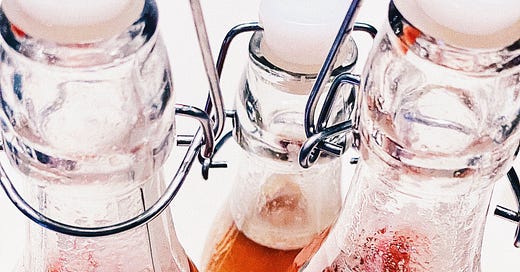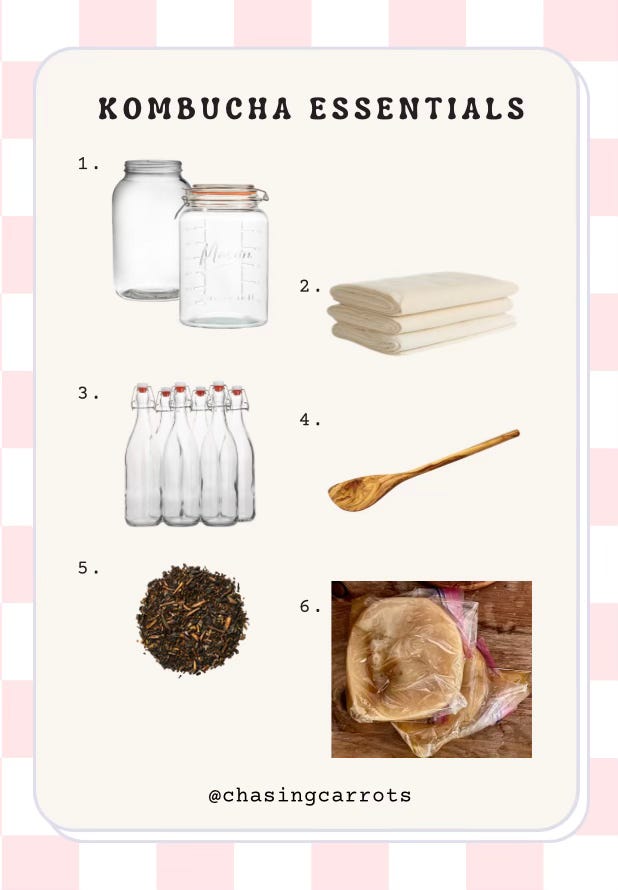Kombucha might seem like a strange place to begin a health journey—tangy, fizzy, fermented with a weird pancake-shaped mushroom called a SCOBY. But for many of us, it’s the first glimpse into a deeper truth: our food is alive, and so are we.
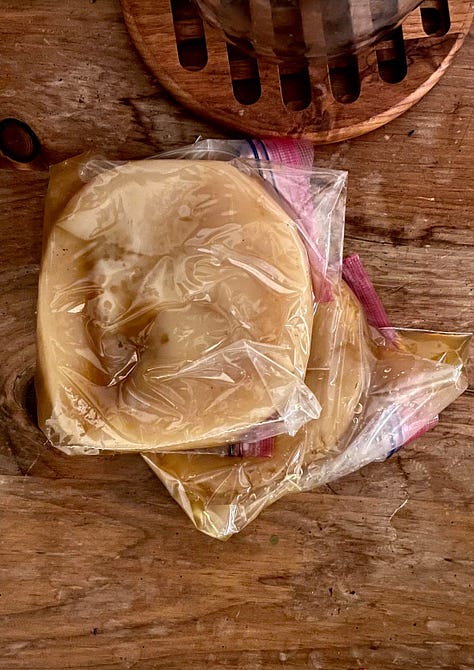
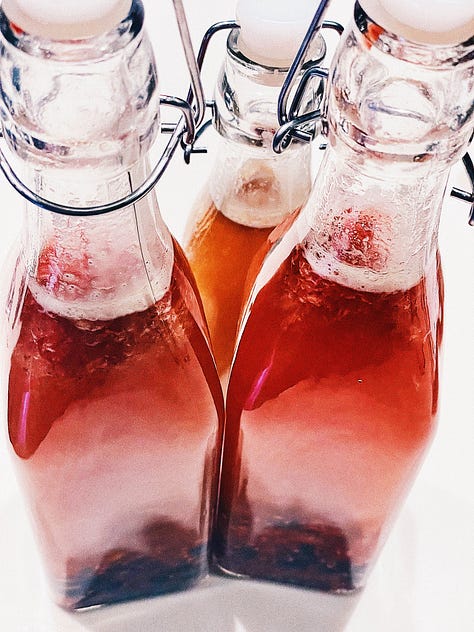
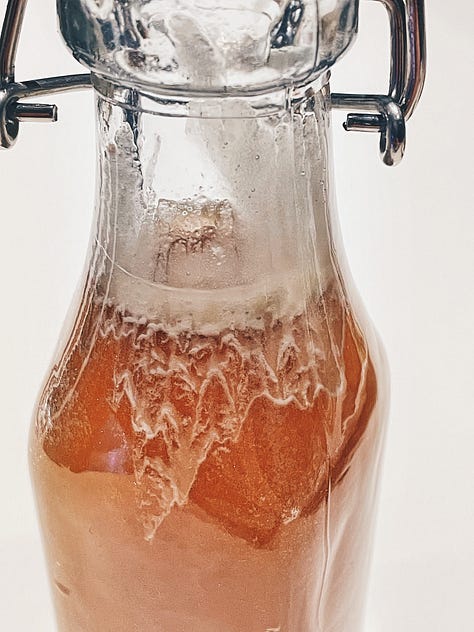
While it may seem like a trendy wellness drink today—kombucha is anything but new… This ancient, fermented tea has been brewed for over 2,000 years, with roots in China, Russia, and Eastern Europe, where it was prized for its energizing and detoxifying properties.1 So yes, while it may be new to your local co-op, it’s been a part of human culture (pardon the pun) for generations—an ancient elixir that’s stood the test of time.
And interestingly enough, it was the first "health food" drink I ever tried. I was seventeen when my friend Rosie handed me a bottle of something cloudy and bubbling. I took a brave sip... and nearly spit it out. It tasted like vinegar. I didn’t understand the appeal—or why anyone would pay for something so sour.
Fast forward a decade: I’ve earned a Master’s in Nutrition, fallen in love with fermentation, and developed a deep curiosity for how food shapes our internal world. What once seemed unpalatable has become a personal staple—not just for the flavor, but for what it represents: a simple, powerful way to support the ecosystem within.
This post is for the curious: whether you're just beginning to explore gut health or you're ready to try brewing your own batch at home. I’ll share the science, the story, and a recipe you can make your own.
In this post, you’ll find:
The science behind kombucha: how it’s made and what makes it so powerful
A refresher on why gut health is central to your wellbeing (hello, Go With Your Gut readers!)
Reframing fear into experimentation: how to safely explore fermentation at home
A step-by-step guide (and shopping list) to making kombucha yourself
The joy of experimenting with flavors and making this ritual your own
Ready? Let’s go down The Rabbit Hole.


Why Kombucha? The Science Behind the Brew
When we think about improving our health, most of us instinctively focus on subtraction—cutting out sugar, processed foods, & stress. But what if the real magic lies in what we add?
Enter kombucha.
Kombucha is a fermented tea made through the alchemy of sweetened tea, bacteria, and yeast. As it ferments, the SCOBY (Symbiotic Culture Of Bacteria and Yeast) digests the sugar and produces a cocktail of beneficial compounds—organic acids like gluconic and acetic acid, enzymes, B vitamins, and trace amounts of alcohol.2 The result? A tangy, slightly sweet, effervescent drink that’s naturally rich in living cultures.
These live cultures—especially strains like Lactobacillus and Acetobacter—can help repopulate the gut with beneficial bacteria, support digestion, and even influence mood and immune function, studies show. But the benefits don’t stop there. Fermentation also enhances the bioavailability of nutrients, making them easier for your body to absorb.
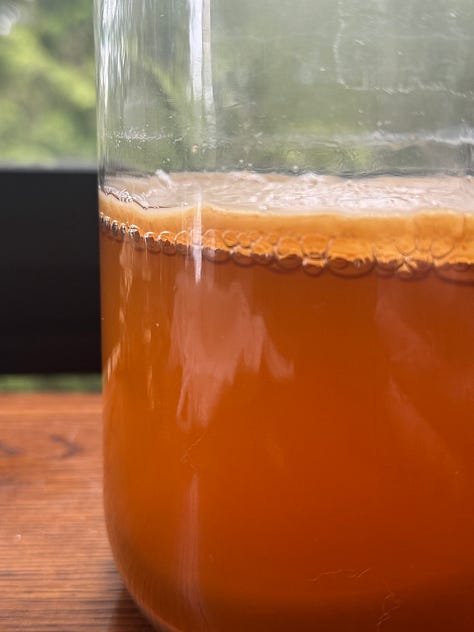

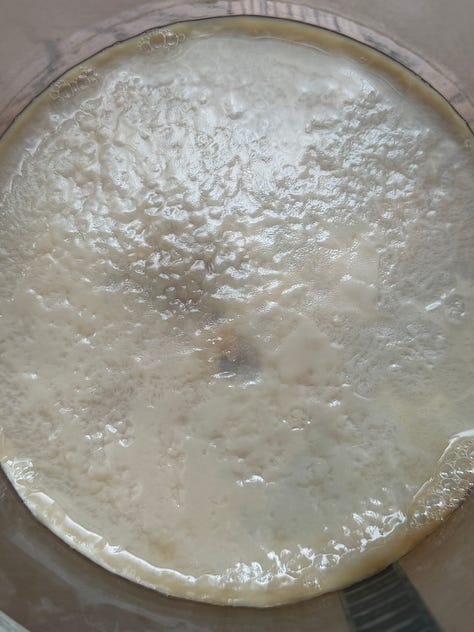
A study published in PubMed highlights the powerful role of fermentation in improving gut microbiota, reducing inflammation, and supporting metabolic health. Kombucha, in particular, offers a unique blend of organic acids, antioxidants, and polyphenols—compounds that may aid in liver detoxification and blood sugar regulation. It’s a small, mighty addition to your routine—one that adds rather than subtracts.
As I pursued my Master’s in Nutrition, I dove deep into gut microbiome research and was continually amazed by how central the gut is to overall health. From hormone balance and inflammation to energy and mental clarity—we are ecosystems, and like any thriving environment, we depend on diversity to flourish.
But here’s the thing: it’s not just about adding in probiotics—you have to feed them too. That’s where whole foods, fiber, color, and variety come in. (If you’ve read my Rabbit Hole 🐇 on Go With Your Gut, you’ll know just how crucial microbial diversity is for vibrant health.)
I love that nature gives more than it takes. In every bubbling jar of kombucha, every fermenting loaf of sourdough, every crock of kraut slowly coming to life—there’s generosity. The process asks for so little: some simple ingredients, a quiet space, a bit of time. And in return, it gives us something far greater than the sum of its parts—something alive, nourishing, and deeply connected to the rhythms of our own bodies.
Gut Health, One Sip at a Time
We often think of the gut as just a digestive organ, but it’s more like a command center—regulating hormones, calming inflammation, communicating with the brain, and training the immune system.3 It’s central to everything from energy and mood to skin health and immunity.
If you’ve read my Rabbit Hole on The Anti-Inflammatory Kitchen, you know that reducing chronic inflammation starts with strengthening the gut lining and nourishing a diverse microbiome. And if you’ve followed along with Go With Your Gut, you already know the gut isn’t just about digestion—it’s an internal garden. The more resilient and balanced it is, the more vibrant our whole body becomes.
That’s where kombucha shines.
It’s not a magic potion, but it is a powerful addition to a gut-conscious lifestyle. Fermented foods like kombucha are rich in probiotics, and studies show that regular consumption can:
Improve nutrient absorption - read more on this in my Rabbit Hole Sourdough: the bread that loves you back post here
Kombucha won’t “fix” your gut on its own—but it’s a beautiful example of a lifestyle shift that aligns with your body’s natural rhythms. It’s an additive habit. Something you can do. Something delicious, functional, and ancient.
Curious to dive deeper? Read the full Rabbit Hole on gut health and hormone balance: find my archives of Rabbit Holes here🐇
Because it’s not about being perfect—it’s about building small, sustainable rituals that nourish. Sip by sip.
Reframing Caution to Curiosity...
I get it—fermentation can feel intimidating. What if it molds? What if I mess it up?
Here’s the truth: your great-grandmother likely brewed kombucha or kefir without a degree or a lab coat. Fermentation is not just a science—it’s a tradition. One you can absolutely be part of.
Making kombucha at home not only saves money, but invites you into a deeper connection with your food. You watch it change. You wait. You taste. You adjust. It becomes a practice—a ritual.
And once you get the hang of it, it’s downright fun.
How to Brew Your Own Honey-Sweetened Kombucha
What You’ll Need:
If you’re starting from scratch, these are a few of of the essentials
Gallon glass jars - You’ll need glass jars with a wide open lid for the first fermentation, these or these will work well.
Cotton cheese cloth - you’ll need something that’s breathable to place over your gallon jar for the first fermentation. Any will do, I got mine from a local store, this is a great option.
For the second fermentation, these air tight bottles would be great, make sure to find air tight bottles with a long neck.
It is important to use glass and wood, and avoid melt during this process. For those reasons any wooden spoon would do, I love olive wood!
Tea - you will need green, black, and/or white tea for this process. Loose leaf or premade tea bags are great options
SCOBY - you can find these online. I got mine from a shop on ETSY.
Recipe:
4 cups filtered water
2–3 black or green tea bags (or 1 Tbsp loose-leaf tea)
¼ cup raw honey (instead of sugar)
4 cups cool filtered water
1 SCOBY (Symbiotic Culture of Bacteria and Yeast)
½–1 cup starter liquid (from a previous batch or store-bought raw kombucha)
A glass jar (at least 1-gallon size)
A breathable cloth and rubber band
Step-by-Step Guide:
Brew the Tea: Boil 4 cups of filtered water, steep tea for 5–10 minutes. Add 4 cups of cool, filtered water to bring the temperature down. (Never add the SCOBY to hot liquid!), then stir in the honey until fully dissolved.
Add the SCOBY & Starter Liquid: Pour the cooled sweet tea into your clean 1-gallon glass jar, add 1 cup of starter tea (this helps lower the pH and prevent mold). Gently place the SCOBY on top (it may float or sink—both are fine).
Cover & Ferment: Cover the jar with a clean cloth or coffee filter and secure it with a rubber band and let it sit in a warm, dark place (around 70–75°F) for 7–14 days.
Taste Test: Start tasting around day 7 using a clean spoon. If it’s too sweet, let it ferment longer; if it’s too tangy, move to the next step.
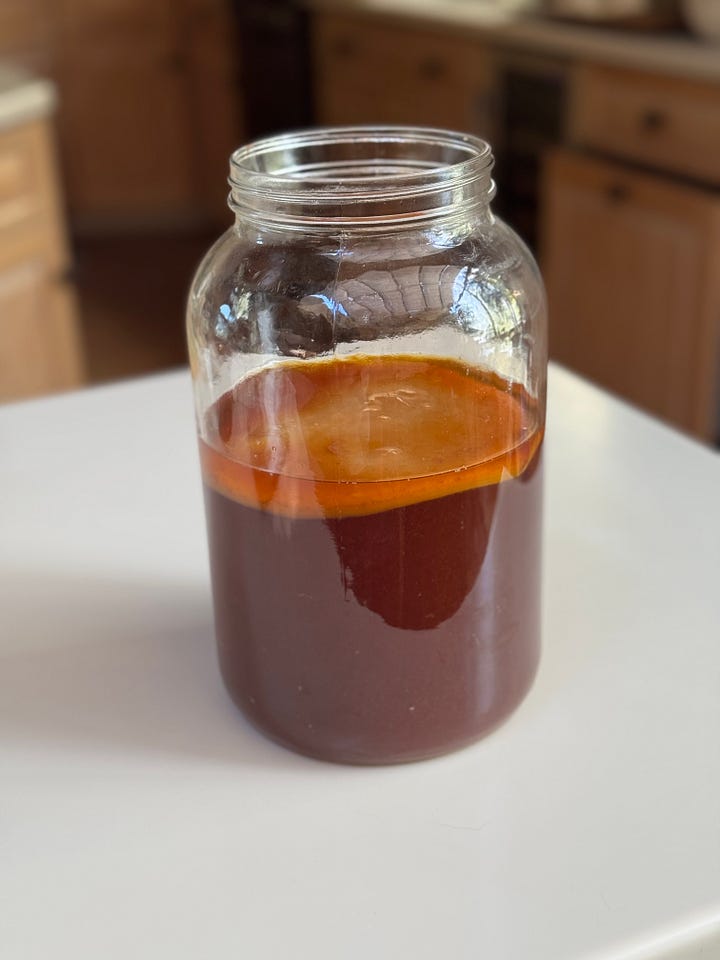
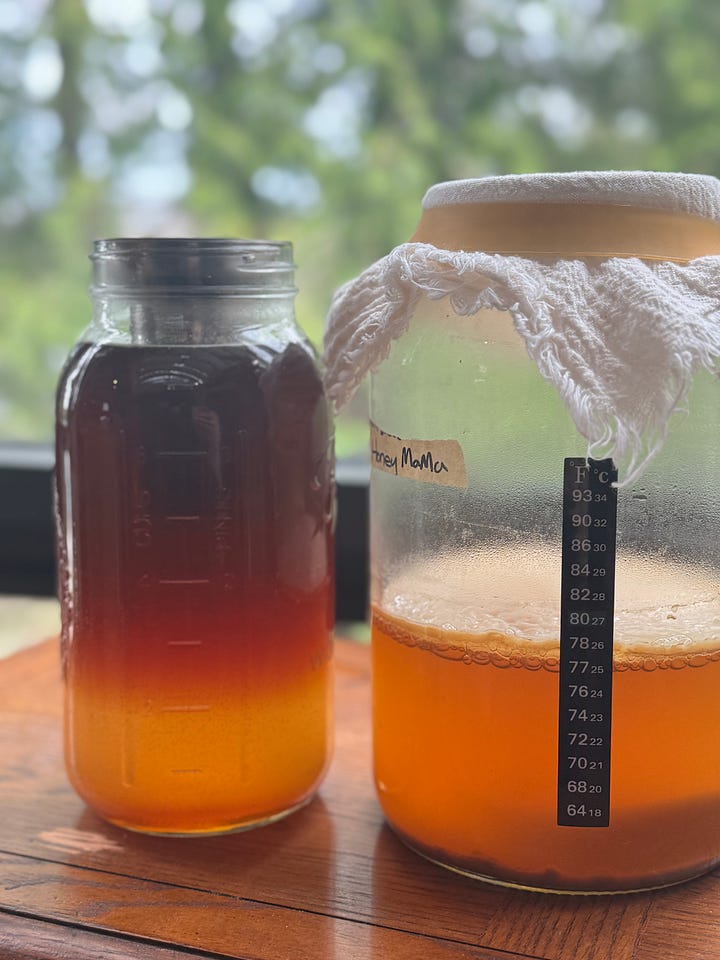
Bottle & Second Ferment:
Remove the SCOBY and reserve 1–2 cups of kombucha for your next batch.
Pour the kombucha into bottles, leaving about an inch of space at the top.
Add flavorings like fruit, ginger, or herbs if desired (see below for some of my flavor experiments).
Seal the bottles and leave them at room temperature for 3–7 days for carbonation.
Refrigerate to slow fermentation and enjoy chilled!
The Joy of Experimenting
One of my favorite things about brewing kombucha is the experimentation. There are endless flavor possibilities, and I love trying new combinations—some surprising, some weird, some absolutely delicious. A few of my favorites:
- Jalapeño Pineapple (sweet heat)
- Chocolate Date (dessert-like and rich)
- Mixed Berry Basil (refreshing)
- Banana (don’t knock it ‘til you try it!)
- Hibiscus Rose (floral and slightly tart)
- Honey Vanilla Chai (warm and cozy)
I love sharing my batches with friends and seeing their reactions—some flavors are instant hits, some need a little tweaking, and some are just fun experiments that make us laugh. It’s all part of the process.
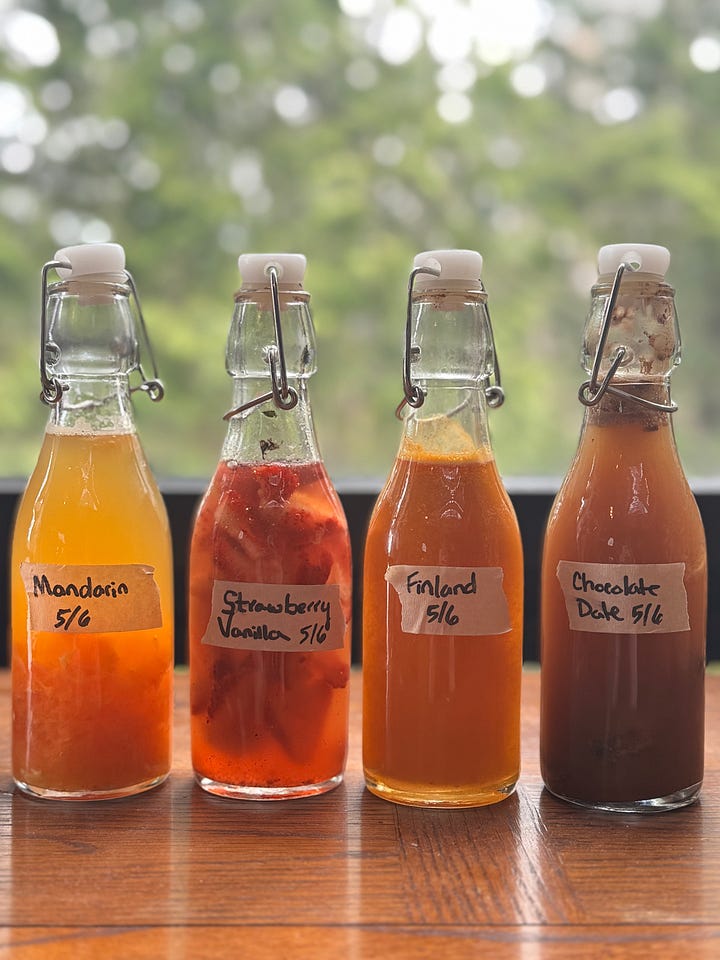
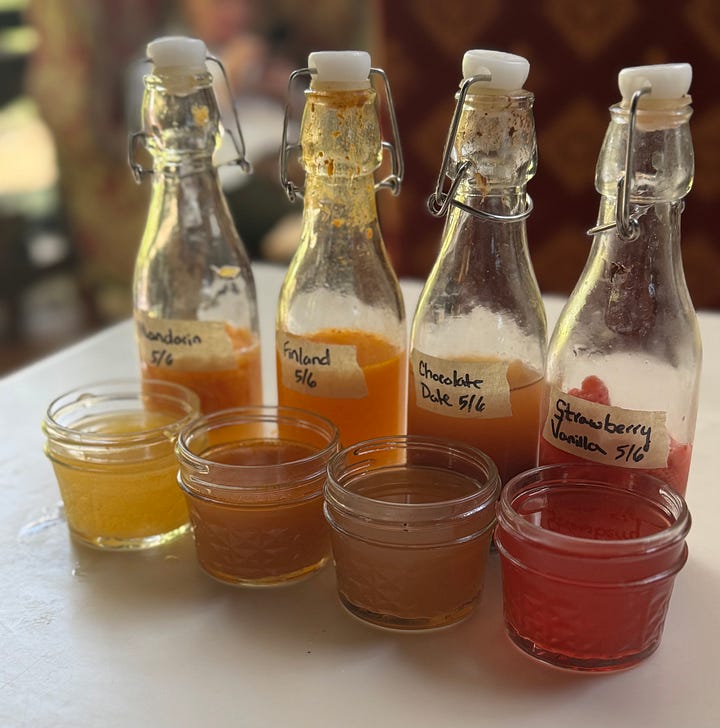
Final Thoughts
Kombucha isn’t a magic bullet. It’s a gateway. A fizzy, living reminder that health isn’t sterile—it’s alive, dynamic, and delicious. It invites us to step into our kitchens, nourish our inner ecosystem, and reconnect with food that’s as alive as we are.
Whether you’re new to fermentation or a seasoned brewer, I hope this rabbit hole leaves you inspired to explore, experiment, and sip with intention.
If you enjoyed this Rabbit Hole, I’d love for you to stick around!!
Subscribe to get notified when I post new (free!) deep dives into nutrition, gut health, and hormone balance—and if you feel called to support my journey, consider becoming a paid subscriber. You’ll unlock more behind-the-scenes content, ingredient breakdowns, and practical recipes to bring these ideas to life in your own kitchen.
Your shares, comments, and restacks truly mean the world to me. 💛 They help this little corner of the internet grow—and remind me that this work matters.
Regardless, Thank you for being here and reading!
— Victoria Louise
Read more on the History of Kombucha https://revolutionfermentation.com/en/blogs/kombucha/kombucha-origins/
Selvaraj, S., & Gurumurthy, K. (2022). An overview of probiotic health booster-kombucha tea. Chinese herbal medicines, 15(1), 27–32. https://doi.org/10.1016/j.chmed.2022.06.010
Read More on the Gut as the Command Center for health https://my.clevelandclinic.org/health/body/the-gut-brain-connection


